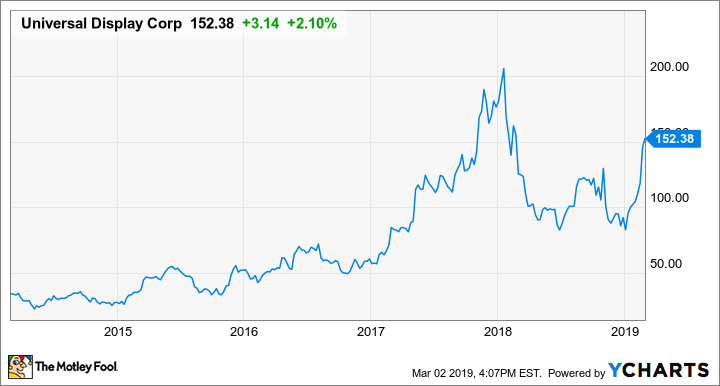Both Universal Display (OLED -0.85%) and Applied Materials (AMAT -0.49%) generate revenue by providing display manufacturers with products required to build display panels.
Universal Display sells materials and licenses patents that are used to manufacture a type of display based on a technology known as organic light-emitting diodes (OLEDs).

Image source: Getty Images.
Applied Materials, on the other hand, is a wider-reaching semiconductor equipment manufacturer. In addition to selling the expensive machines that are used by chip makers to manufacture smaller, more efficient chips, Applied Materials also sells machines to display manufacturers that allow them to build displays of all kinds, including liquid crystal displays (LCDs) and OLEDs.
Between the two stocks, I'd give the nod to Applied Materials. Here's why.
Cheaper valuation, broader market exposure
Universal Display is a pure play on the adoption of OLED screens -- something that's certainly been happening and is likely to continue for the foreseeable future. As a result, the company is expected to grow at an incredible clip over the next couple of years, with analysts calling for the company to post revenue growth of 36.3% and 38.3% in its fiscal 2019 and 2020, respectively.
With that being said, investors are certainly paying a substantial premium for that growth. The stock trades at 74.3 times analysts' fiscal 2019 earnings per share (EPS) estimates and around 40.3 times their fiscal 2020 expectations. I'm not saying that expensive stocks are necessarily bad investments, but I do think they tend to be riskier, since if a richly valued company fails to meet expectations, it could lead to a large drop in the stock price. (This has actually happened to Universal Display stock several times over the last five years.)
Applied Materials, on the other hand, is an extremely cheap stock. The company trades at about 13 times fiscal 2019 estimates and 10.3 times fiscal 2020 estimates.
Now, just as an expensive stock isn't necessarily something to avoid, a cheap stock won't automatically be a great investment, either. Indeed, Applied Materials is likely so cheap because the company is staring down a 15.9% revenue decline for fiscal 2019 (thanks to a significant slowdown in semiconductor equipment spending, due substantially to plummeting memory prices) before it's expected to deliver 9% growth in the following year.
Nevertheless, what I like about Applied Materials is that, in addition to its cheap valuation, it has broad exposure to the semiconductor market -- including logic, memory, and display manufacturing -- and I buy into the company's vision that, over the long term, the increases in the complexity of each of these products will favorably impact the demand for Applied Materials' equipment.
Universal Display is a very good pure play on OLED screen adoption -- a fact that should allow it to outgrow the overall display market for quite a while -- but if OLED screen technology were ever to be displaced, Universal Display's business could wind up in shambles.
Applied Materials, on the other hand, stands to profit from the transition to OLED, but if OLED were ever to become old news, the company's display segment would likely continue on profiting from the next big thing. And, of course, Applied Materials' business is about far more than displays.
For some perspective, during fiscal 2018, its display and adjacent markets segment revenue was about $2.5 billion -- just shy of 14.5% of the company's overall revenue. The rest came from its semiconductor systems, as well as its global services segments.
Investor takeaway
For me, Applied Materials is the stock I'd rather have in my portfolio. The relatively cheap valuation and exposure to a broad cross section of the semiconductor industry seems to offer a better risk-to-reward balance than sizzling-hot-but-richly valued Universal Display. (I should also note that Universal Display stock has risen about 67% year to date.)






